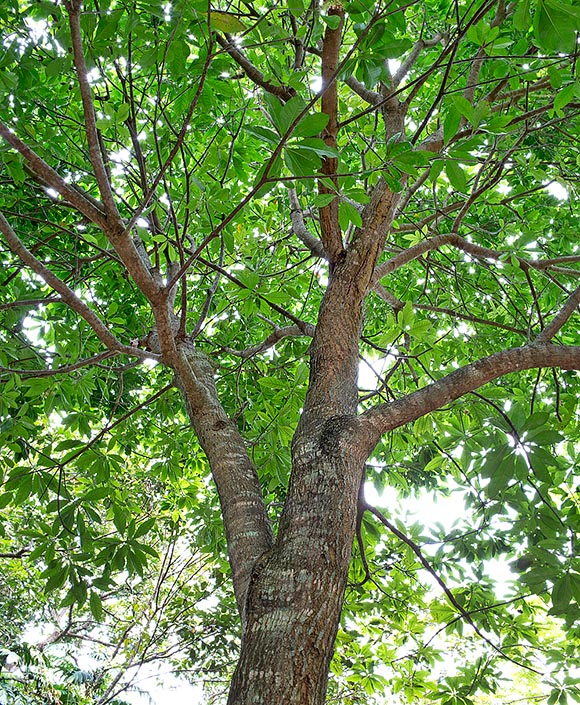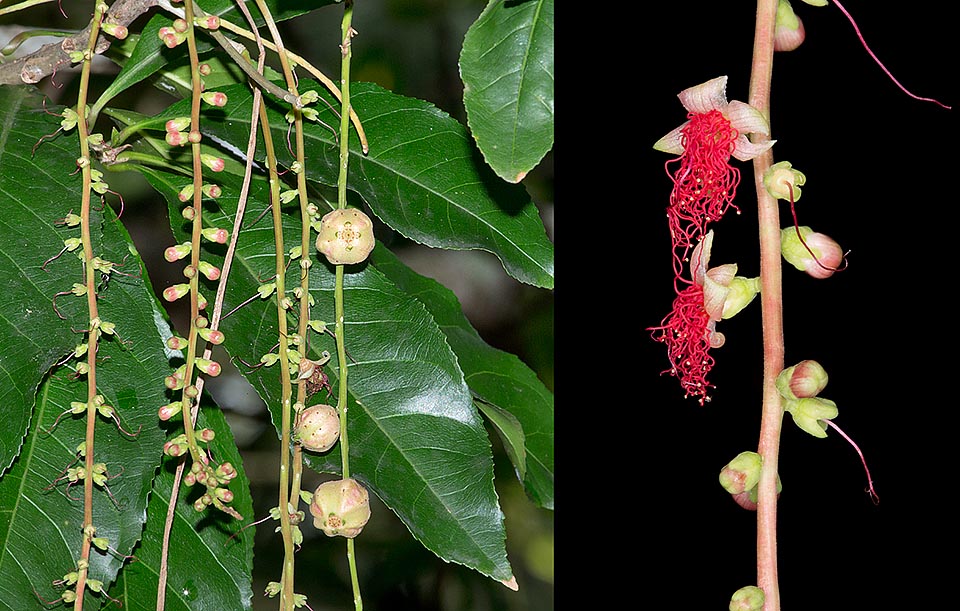Family : Lecythidaceae

Text © Pietro Puccio

English translation by Mario Beltramini

Barringtonia acutangula is a very ramified tree that in South East Asia can be 15 m tall with trunk of 20-50 cm of diameter. All plant parts are much used in the traditional medicine © Giuseppe Mazza
The species is native to Afghanistan, Assam, Australia (New South Wales and Queensland), Bangladesh, Borneo, Cambodia, India, Laos, Lesser Sunda Islands, Myanmar, Pakistan, Peninsular Malaysia, Philippines, Singapore, Sri Lanka, Sulawesi, Sumatra, Thailand and Vietnam where it grows in the deciduous as well as evergreen forests, mainly along the banks of the water streams and lagoons and in swampy areas, where often is the dominant species, from the sea level up to about 400 m of altitude.
The genus is honoured to the English lawyer and naturalist Daines Barrington (1727-1800); the specific name is the combination of the Latin adjective “acutus, a, um” = acute, sharp, and of the substantive “ angulus” = angle, point, with reference to the fruits with usually tetragonal section and prominent angles.
Common names: cut nut, freshwater mangrove, Indian-oak, itchytree, mango-pine, mangobark, stream barringtonia (English); hendol, hinyol, pani amra (Assamese); hijal (Bengali); kyeni, kyi (Burmese); apaling, kalambuaia, latuba, putad, sako, tuba (Tagalog); hijagal, hijjal, samundarphal (Hindi); mavinkubia, niruganigily, dhatripala (Kannada); ka don nam, ka don noy (Lao); arru peḻ, attampu, attupelu, nir perzha (Malayalam); jurai-jurai, putat nasi (Malaysian); tiwar, newar, sathaphala, samudraphala (Marathi); abdhiphala, ambudhiphala, ambuja, vidula (Sanskrit); aram, kadambu, kadappai, samudra pazham (Tamil); kurpal (Telugu); chik, chik na, chik nam, kradon thung, tong (Thai); samandarphal (Urdu); lộc vừng, chiếc đỏ, lộc vừng hoa trắng, chiếc hoa trắng, mưng (Vietnamese).
The Barringtonia acutangula (L.) Gaertn. (1791) is a shrub or much ramified evergreen or briefly deciduous tree, 10-15 m tall, with trunk of 20-50 cm of diameter and brown bark, wrinkled, vertically fissured, rich of tannins. The leaves, on an about 1 cm long petiole, are simple, alternate, oblong to obovate-elliptic with pointed apex and margins at times finely serrate, 6-18 cm long and 3-7 cm broad, coriaceous, glossy above, of intense green colour.
Inflorescences in drooping terminal racemes, up to 50 cm long, with numerous hermaphroditic flowers of 2-3 cm of diameter with 4 semi-circular green sepals, 2-4 mm long and 2-3 mm broad, and 4 elliptic petals (rarely 5), 0,6-1,2 cm long and 0,4-0,7 cm broad, of white to pink, to red colour, and numerous 1-2 cm long pink to intense red stamina.
Indehiscent ovoid fruits, 2-6 cm long and of 1-3 cm of diameter, with section from tetragonal with prominent edges (more frequently) to octagonal, containing one blackish ovoid seed, 1-4 cm long and of 0,5-1,5 cm of diameter, poisonous. It reproduces by seed, which has a short germinability duration, previously kept in lukewarm water for two days, in organic loam, with addition of sand or perlite per a 30% to improve the drainage, maintained humid at the temperature of 24-26 °C, with germination times of 1-3 months, and by semi-woody cutting. Amply diffused species in the origin zones, cultivable exclusively in the tropical and humid subtropical climate zones where at times is utilized in the gardens as ornamental, due to the foliage and the long drooping inflorescences, as shade tree or for windbreaks.
It requires a position in full sun or slightly shaded and grows in an ample variety of soils, even if heavy clay and little draining, maintained constantly humid, does not bear long drought periods and temperatures close to 0 °C.

Close-up of leaves and fruits with prominent edges. Right, enlarged inflorescence with colourful stamina next to fall © Giuseppe Mazza
All parts of the plant are widely utilized since remote times in the traditional medicine, in particular in the Indian one, where the species occupies a prominent position, for various pathologies, and its components are under study for a possible use in the official pharmacopoeia. The wood, light and easy to work, is used for furniture, boats, tools and various handicrafts, as well as fuel.
In some populations devoted to fishing, the branches, without the leaves, and duly treated to reduce the poisonous effects, are used for creating a habitat suitable for the fishes, protect them against the predators and furnish food through the algae growing on their surface. In some locations, bark, branches and crushed seeds are used to stun the fishes thus rendering easy their capture.
Synonyms : Eugenia acutangula L. (1753); Meteorus coccineus Lour. (1790); Butonica acutangula (L.) Lam. (1794); Stravadium rubrum Pers. (1806); Caryophyllus acutangulus (L.) Stokes (1812); Stravadium acutangulum (L.) Sweet (1826); Stravadium coccineum (Lour.) DC. (1828); Barringtonia alba Kostel. (1835); Barringtonia coccinea (Lour.) Kostel. (1835); Botryoropis luzonensis C.Presl (1851); Stravadium costatum Blume (1851); Stravadium rheedei Blume (1851); Barringtonia costata (Blume) Miq. (1855); Butonica rubra Miers (1875); Stravadium demissum Miers (1875); Stravadium denticulatum Miers (1875); Stravadium gracile Miers (1875); Stravadium luzonense (C.Presl) Miers (1875); Stravadium pubescens Miers (1875); Barringtonia luzonensis (C.Presl) Vidal (1885); Barringtonia nitida Miq. (1855); Barringtonia rubra Baill. ex Laness. (1886); Michelia acutangula (L.) Kuntze (1891); Michelia costata (Blume) Kuntze (1891); Michelia luzonensis (C.Presl) Kuntze (1891); Michelia nitida (Miq.) Kuntze (1891); Huttum acutangulum (L.) Britten (1901); Barringtonia tetraptera Lauterb. (1910); Symplocos multiflora Eberh. & Dubard (1913); Barringtonia schmidtii Warb. ex Craib (1915); Barringtonia micrantha Gagnep. (1918); Careya coccinea (Lour.) A.Chev. (1919); Barringtonia eberhardtii Gagnep. (1920); Barringtonia edaphocarpa Gagnep. (1920); Barringtonia pedicellata Ridl. (1920); Barringtonia multiflora (Eberh. & Dubard) Guillaumin (1924); Barringtonia bicolor Craib (1929); Barringtonia kermodei C.E.C.Fischer (1929); Barringtonia balansae R.Knuth (1939); Barringtonia demissa (Miers) R.Knuth (1939); Barringtonia denticulata (Miers) R.Knuth (1939); Barringtonia gracilis (Miers) R.Knuth (1939); Barringtonia kedahensis R.Knuth (1939); Barringtonia martensii R.Knuth (1939); Barringtonia merguiensis R.Knuth (1939); Barringtonia pubescens (Miers) R.Knuth (1939).
→ To appreciate the biodiversity within LECYTHIDACEAE family please click here.
